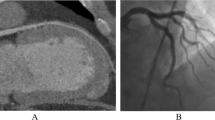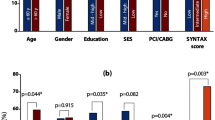Abstract
This study aimed to determine the expected treatment benefits from the patient’s perspective before and after percutaneous transluminal coronary angioplasty (PTCA). Descriptive study. The sample consisted of 60 patients that underwent PTCA in the cardiology department of a university hospital in Bolu province in Turkey. The patients were interviewed one hour before the procedure and a week after discharge from hospital. The proportion of patients that perceived their health as good after the PTCA was two-fold in comparison to before (48.3%, 88.3%) (P < 0.05). The rate of patients taking heart disease seriously decreased by half after PTCA compared to before (40.0%, 83.3%) (P < 0.05). Almost all of the patients had the wrong interpretation of complete recovery from the diseases before and after PTCA (100.0%, 96.7%) (P > 0.05). Expectations of not having chest pain (P > 0.05), not having MI (P > 0.05), not having fear of death (P < 0.05), and not having stress (P > 0.05) were lower after PTCA in comparison to before. The expectation of not having chest pain was higher in women (60.9%, 47.8%) (P > 0.05), in those not having MI (56.1%, 48.8%) (P > 0.05), and in those having chronic diseases (59.0%, 43.6%) (P > 0.05) before PTCA compared with after. The majority of the patients had the wrong interpretation regarding their PTCA expectations, which decreased dramatically after the procedure. Continuing individualized health education programs on angioplasty for patients and their families will be an important way of dealing with patients’ inaccurate interpretations.
Similar content being viewed by others
Abbreviations
- CAD:
-
Coronary artery disease
- PTCA:
-
Percutaneous transluminal coronary angioplasty
References
WHO (2000) The World Health Report 2000—Changing History. WHO Library Catalogue in Publication Data, Copenhagen, pp 164–174
Chamuleau SA, Van Eck-Smit BL, Meuwissen M, Piek JJ (2002) Adequate patient selection for coronary revascularization: an overview of current methods used in daily clinical practice. Int J Cardiovasc Imaging 18:5–15
Dzavik V (1998) The need for revascularization procedures will remain the same or increase in the next decade. Can J Cardiol 14:27A–314A
Sancaklar O, Aytekin V, Kozan Ö, Ömürlü K, Öztürk S, Özmen F (2001) Türkiye’de invaziv kardiyoloji: 2000 yılı sonucları. Türk Girisimsel Kardiyoloji Dergisi 5:193–203
Gulanick M, Naito A (1994) Patients reactions to angioplasty: realistic or not? J Crit Care 3:368–372
Gulanick M, Bliley A, Perino B, Keough V (1997) Patients’ responses to the angioplasty experience: a qualitative study. Am J Crit Care 6:25–32
Kimble LP, King KB (1998) Perceived side effects and benefits of coronary angioplasty in the early recovery period. Heart Lung 27:308–314
Cronin SN, Freemen LH, Ryan G, Drake DM (2000) Recovery after percutaneous transluminal coronary angioplasty: assessment after discharge. Crit Care Nurs 20: 70–76
Walker ML (2004) Cardiac rehabilitation: the importance of patient expectations—a practitioner survey. J Clin Nurs 13:177–184
Levenstein JH, McCracken EC, McWhinney IR, Stewart MA, Brown JB (1986) The patient centered clinical method. 1. A model for the doctor–patient interaction in family medicine. Fam Pract 3:24–30
Lunde IM (1993) Patients’ perceptions—a shift in medical perspective. Scand J Prim Health Care 11:98–104
Cronqvist A, Wredling R, Nordlander R, Languus A, Björvell H (2000) Perceived discomfort and related coping phenomena in patients undergoing PTCA. Coron Health Care 4:123–129
Higgins M, Dunn S, Theobald K (2000) The patients’ perception of recovery after coronary angioplasty. Aust Crit Care 13:83–88
Permanyer-Miralda G, Alonso J, Brotons C, Cassant P, Ribera A, Moral I, Romero B, Domingo E, Anto JM, Soler-Soler J (1999) Perceived health over 3 years after percutaneous coronary balloon angioplasty. J Clin Epidemiol 52:615–623
Holmboe ES, Fiellin DA, Cusanelli E, Remetz M, Krumholz M (2000) Perceptions of benefit and risk of patients undergoing first time elective percutaneus coronary revascularization. J. Gen Intern Med 15:632–637
Kee F, McDonald P, Gaffney B (1997) Risks and benefits of coronary angioplasty: the patients perspective: a preliminary study. Qual Health Care 6:131–139
Kunt AE, Mackenbach JP (1994) Measuring socioeconomic inequalities in health. WHO Pub., Copenhagen, pp 18–20
Pocock SJ, Henderson RA, Seed P, Treasure T, Hampton JR (1996) Quality of life, employment status, and anginal symptoms after coronary angioplasty or bypass surgery: 3-year follow-up in the randomized intervention treatment of angina trial. Circulation 94:135–142
Jensen K, Banwart L, Venhaus R, Popkess-Vawter S, Perkins S (1993) Advanced rehabilitation nursing care of coronary angioplasty patients using self-efficacy theory. J Adv Nurs 18:926–931
Gulanick M, Bliley A, Perino B, Keough V (1998) Recovery patterns and lifestyle changes after coronary angioplasty: the patient’s perspective. Heart Lung 27:253–262
Wenger NK (1992) Improved quality of life after PTCA: generalizability and concerns. Cathet Cardiovasc Diagn 27:95–96
Perkins S, Jenkins LS (2000) Self-efficacy expectation, behavior performance, and mood status in early recovery from percutaneous transluminal coronary angioplasty. Heart Lung 27:37–46
Gentz CA (2000) Perceived learning needs of the patient undergoing coronary angioplasty: an integrative review of the literature. Heart Lung 29:161–172
Moser DK, Dracup K (1995) Psychosocial recovery from a cardiac event: the influence of perceived control. Heart Lung 24:273–280
White RE, Frasure-Smith N (1995) Uncertainty and psychologic stress after coronary angioplasty and coronary bypass surgery. Heart Lung 24:19–27
Acknowledgment
The authors would like to thank the patients for their efforts and cooperation.
Author information
Authors and Affiliations
Corresponding author
Rights and permissions
About this article
Cite this article
Ozkan, O., Odabası, J. & Ozcan, U. Expected treatment benefits of percutaneous transluminal coronary angioplasty: the patient’s perspective. Int J Cardiovasc Imaging 24, 567–575 (2008). https://doi.org/10.1007/s10554-008-9297-1
Received:
Accepted:
Published:
Issue Date:
DOI: https://doi.org/10.1007/s10554-008-9297-1




